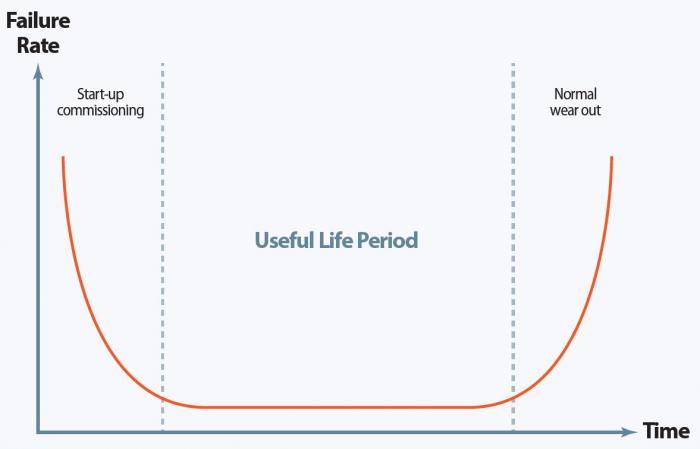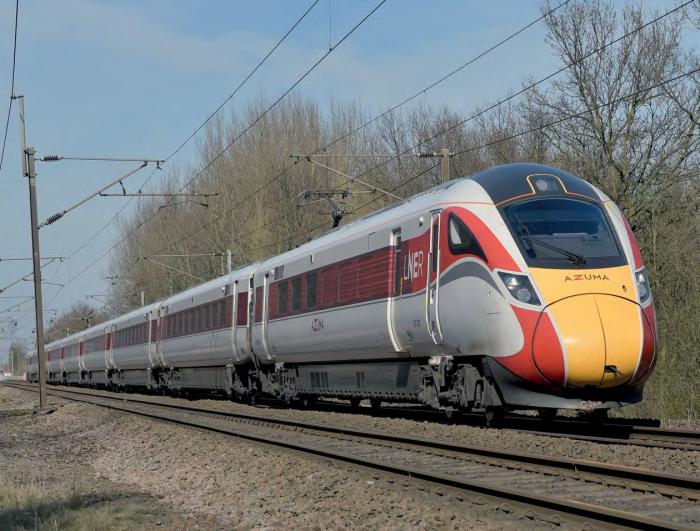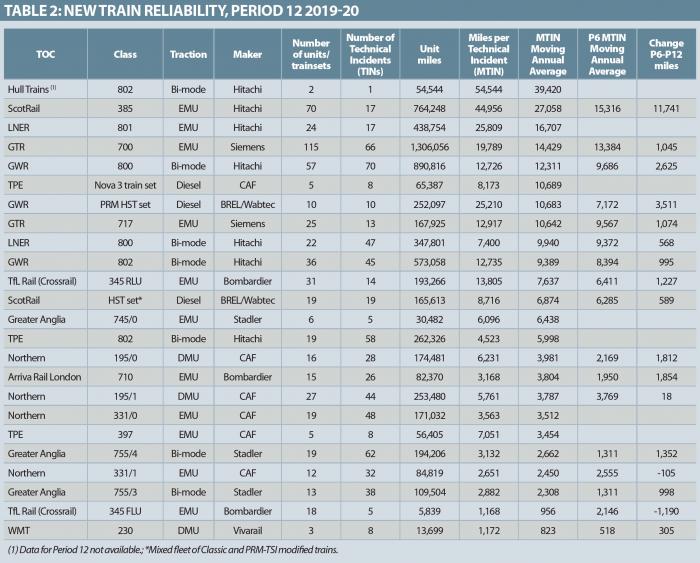No new entries this month, so I thought it might be time to see how the longer-established fleets are progressing down the reliability ‘bathtub curve’. Hence the additional columns in this month’s table.
Just to recap, if you plot the number of failures for a new product against time on a graph, you start with high numbers, which should, in theory, fall steeply as infant mortalities and inherent weaknesses are eliminated. When reliability stabilises, the graph flattens out and resembles the end of a bath (Figure 2).
There is no acknowledged yardstick for the time we should expect new train fleet reliability to slide down the end of the bath and level out. But if we compare the Period 12 Miles per Technical Incident Moving Annual Average (MTIN MAA) with the results from Period 6 in this month’s table, it looks as though we are going to have to wait a long time.

Why have I not shown the percentage improvement? Well, 100% of not much is still not much. For example, the Greater Anglia Stadler Class 755/4 bi-modes have improved by a massive 103%, but 2,662 MTIN MAA is not exactly the full Toblerone.
At the top of the table, percentages do give a limited guide to improvement. ScotRail and Hitachi continue to shine with a 77% improvement for the Class 385 fleet over six Periods, showing, dare I say it, a touch of the Wimbledons.
Similarly, the 8% gain for the Govia Thameslink Railway Siemens Class 700 fleet suggests some reliability issues are proving recalcitrant. The 27% gain for the Great Western Hitachi Class 800 bi-modes gives an indication of the benefits of extended operation under electric traction. And the 49% improvement for the GWR Castle Class short formation IC125s is also encouraging.
But, otherwise, there is not much comfort to be found in this comparison.

ASPIRATIONS REVISITED
Back in 2015 we were all diverted by the Office of Rail and Road access hearings over applications for paths on the East Coast main line. Looking back at those innocent times, I found this passage in a letter from then franchise operator Virgin Trains East Coast particularly apposite to this month’s table.
‘High levels of fleet performance will support our May 2020 timetable. Given our core fleet in the May 2020 timetable will be IEP, we are extremely confident that we will deliver the reliability levels required to deliver the step change in reliability that we are contracted to deliver. The reliability levels for IEPs are 27,000 MTIN for Class 800 bi-mode and 54,000 for Class 801 electric trains. This level of reliability is underpinned by a (TARA) with Hitachi’. A TARA is the Train Availability & Reliability Agreement in the IEP paperwork.
Factors supporting this confidence included the reliability of Southeastern’s Hitachi Class 395 units, and a ‘robust’ availability level of 83% (averaged across the whole IEP fleet) which would ensure adequate time spent on train maintenance in depots, with defined ‘generous overnight downtime requirements’.
Now, here we are in 2020 and the table of truth tells a different story. But, to give it credit, Hitachi is the top manufacturer when it comes to new train reliability, holding four of the first five spots.
LNER FLEET PLANS
Last month TIN-Watch referred briefly to the availability issues caused by LNER’s mix of nine-car and five-car electric and bi-mode trains under DfT’s Intercity Express Programme (IEP). I followed this up with the ever-helpful LNER media team, which provided this fleet-by-fleet rundown on what happens next. A caveat: the reduced timetable due to coronavirus has disrupted these plans, with LNER opting to store most of the five-car Azumas and focus on using nine-car sets and a small number of IC225s.
NINE-CAR CLASS 800 (BI-MODE)
When the final set is accepted there will be 13 trains. Contractually, the maximum number of sets to be available is 10 (77% availability). This is currently reduced to nine pending repairs to No 800109 which was damaged in the depot collision with an HST at Neville Hill in November (p98, January issue).
Between May 2020 and the start of the new timetable in December 2021 the target will remain at nine diagrams to accommodate a modification programme. From December 2021 the contractual 10 diagrams will be required.
FIVE-CAR CLASS 800 (BI-MODE)
Contractual maximum sets available is eight from 10 (80% availability). Currently the 10 sets are covering seven passenger and one driver trainer diagram.
From the May 2020 timetable change target availability will be reduced to six diagrams to make spare sets available for the modification programme. Availability will return to eight passenger diagrams from December 2021.

FIVE-CAR CLASS 801/1 (ELECTRIC)
Contractual maximum sets available is 10 from 12 (83% availability). From the May 2020 timetable the 10 passenger diagrams will be reduced to a target of seven, also to provide cover for the modification programme. All 10 diagrams will be required from December 2021.
NINE-CAR CLASS 801/2 (ELECTRIC)
These trains, the direct replacement for the IC225 fleet, are still being delivered, with 30 sets on order. Under the contract a maximum of 26 will be required in service (87% availability). From May 2020 the number of passenger diagrams will be ramped up, starting at 22 and rising to 25 diagrams covered by ‘late summer’. As with the other sub-fleets, the ‘spare’ diagram will allow for one set out of service for modification. As with the rest of the fleet the contractual number available will be required for December 2021.
2+9 IC225 (LOCO-HAULED ELECTRIC)
From May LNER is expecting the legacy IC225s to be covering seven diagrams including a ‘hot spare’. As nine-car Class 801/2 deliveries continue, from ‘late summer’ 2020 the number of IC225 diagrams will reduce to four, again including a hot spare, and then remain at that level until December 2021.
Meanwhile, during 2021 LNER is planning another programme of overhauls and enhancements for the IC225 fleet in preparation for December 2021 when the new timetable will require nine diagrams including a hot spare.
